Unai Emery’s Villarreal are finally starting to show what they’re truly capable of. Even though their 2-1 victory over a deserted Valencia doesn’t mean much, the tactics and the principles deployed were promising.
This tactical analysis will aim to show you just how the Yellow Submarine got the better of the Bats of Valencia and what issues still plague the latter team.
Lineups
Emery only made two changes to the team that drew with Atletico Madrid in their last LaLiga clash. Sergio Asenjo was once again in goal and in front of him, a quartet consisting of Mario Gaspar, Raúl Albiol, Pau Torres and Alfonso Pedraza, who replaced Pervis Estupiñán.
In midfield, more familiar faces with Vicente Iborra in the pivot role and Dani Parejo and Manu Trigueros ahead of him. Finally, Moi Gómez and Samuel Chukwueze manned the flanks – with the former replacing the injured Gerard Moreno – while Paco Alcácer was deployed upfront.
Villarreal were in a 4-1-4-1 formation.
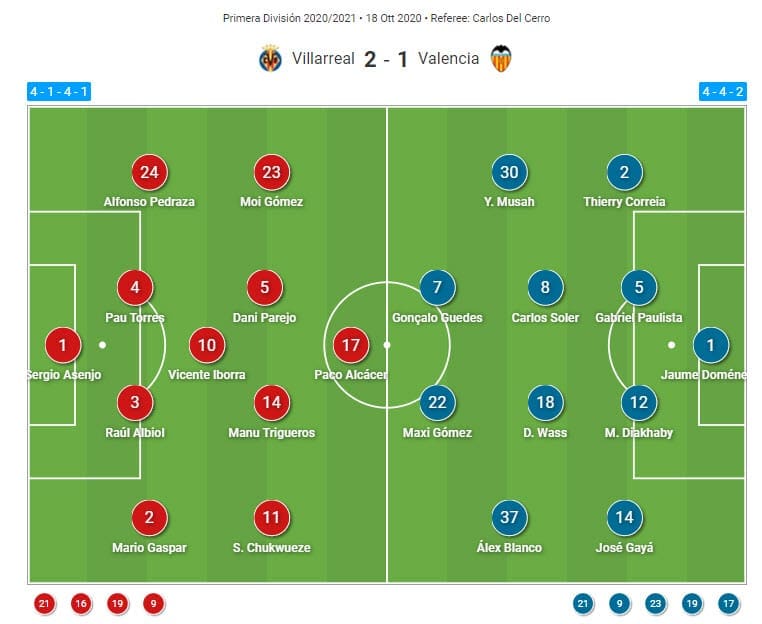
Javier Gracia, on the other hand, made more changes. Jaume Doménech was, of course, between the sticks but we saw some movement in the backline. José Gayá, Mouctar Diakhaby and Thierry Correia retained their places but Gabriel Paulista returned in the lineup ahead of Hugo Guillamón.
Carlos Soler and Daniel Wass were the central midfielders, the former replacing the injured Geoffrey Kondogbia, while Álex Blanco and the young Yunus Musah slotted out wide. Gonçalo Guedes and Maxi Gómez formed the striker partnership up top.
Valencia were deployed in a 4-4-2 structure.
Villarreal’s positional play vs Valencia’s lacking pressing tactics
We will start this tactical analysis with the hosts’ attack and see how the former Arsenal man’s tactics interacted with Gracia’s defensive structure. In general, it has to be said that Villarreal mostly dominated the clash despite the scoreline suggesting a rather tight affair on the night.
Villarreal were set up in a 4-1-4-1 formation but in possession, that system looked like a 2-1-4-3 that shifted to a 3-4-3 to bypass Valencia’s press. The Bats, on the other hand, were set up in a 4-4-2 defensive mid-block and were not overly aggressive.
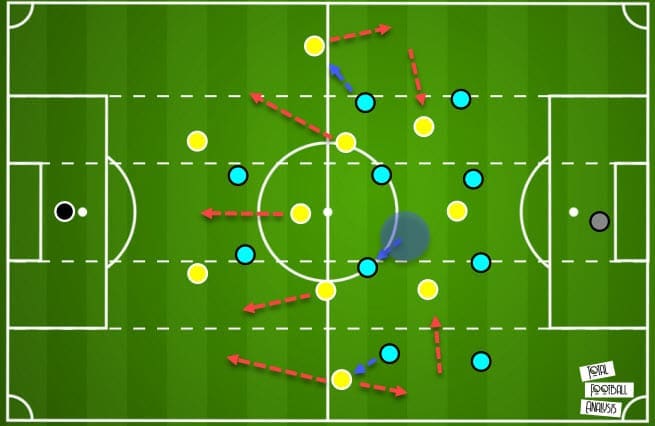
You can see the general setup of both teams in the graphic above. I’ve highlighted all the possible variations Villarreal used in their tactics to outplay Valencia in the first phase of attack. Note that all of those moves would not happen at once but rather the graph illustrates multiple different options at once.
Villarreal had three main patterns they utilised to overcome Valencia’s first line of press. In order to create a 3v2 in the build-up phase, one of Parejo, Iborra or Gaspar would stay deeper, forming a three-man defence with the backline. The main idea behind all three moves was the same: drag one of the midfielders from the second line of Valencia’s defence to create a pocket of space to exploit.
Note one such example below as Parejo drops to a left centre-back position, prompting Blanco to move up and opening a channel for Iborra to exploit once he receives the ball.
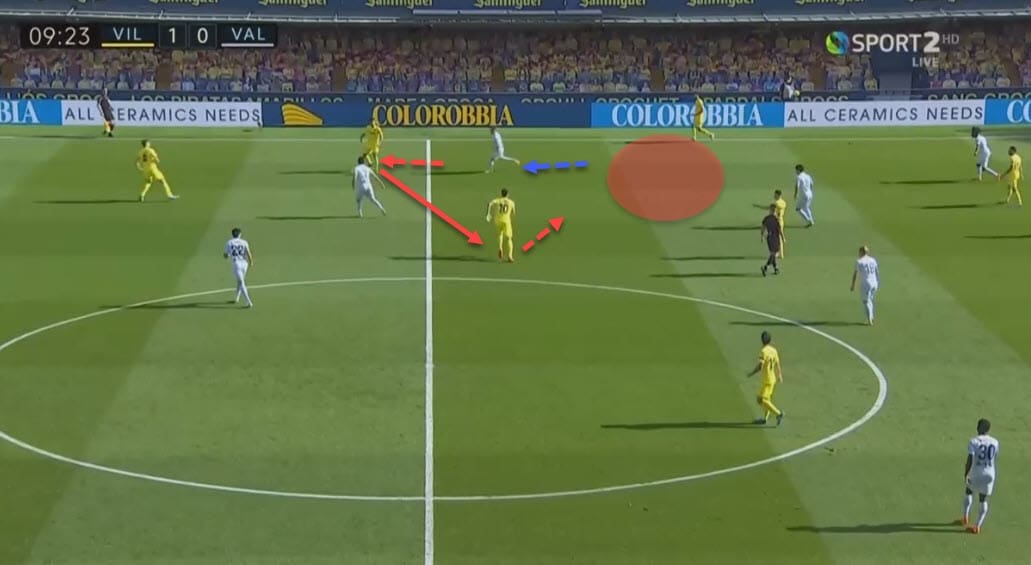
We’ve seen the same type of movement utilised multiple times across the game. On the other side, Iborra would drop deeper towards the right centre-back position, pull Wass towards him and then open the half-space for Chukwueze to exploit. This was extremely effective once in the final third too but we’ll discuss it more later on in this analysis.
There were instances when Iborra would drop between the centre-backs but Villarreal usually preferred putting their midfielders wider so they can run forward with the ball rather than staying centrally. Another option was dropping Gaspar deeper, in which case Trigueros would drift wide so the ball can be progressed through the flanks.
Valencia had pretty standard tactics when defending in a 4-4-2 mid-block. The two forwards would track the ball and once it was recycled wide, it would activate the wide midfielders who engaged in the press. Higher up the pitch, they shifted in a 4-3-3 to try and match Villarreal’s three-man backline and if they pushed to the opposition’s box, the structure would change to a 4-1-3-2 with (mostly) Wass staying back.
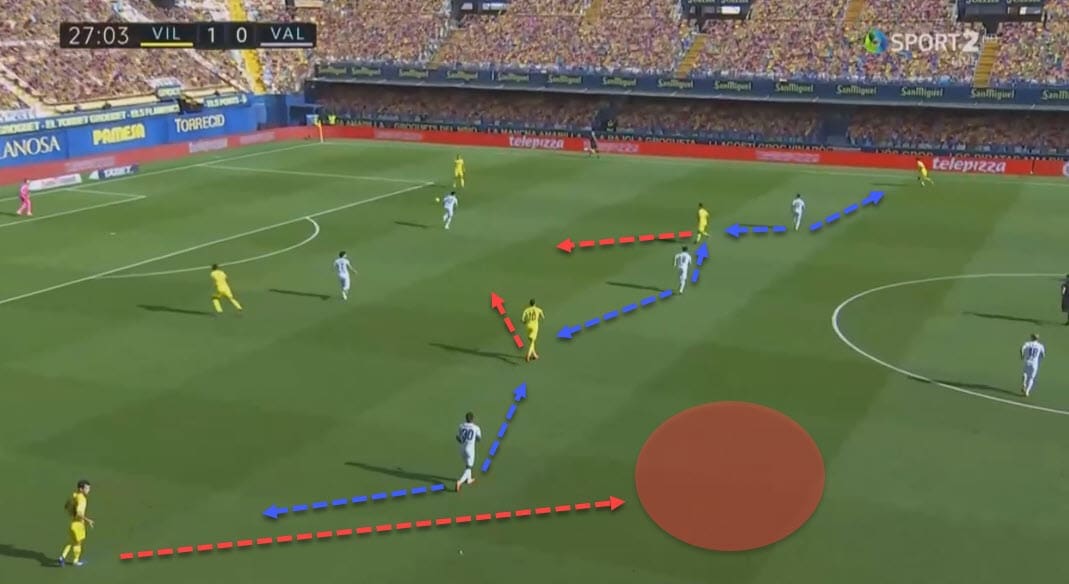
But as you can see above, this didn’t interact well with Emery’s build-up tactics. Villarreal would easily achieve numerical superiority in midfield with two pivots and two full-backs on either side of the pitch, putting Valencia’s pressing squad in a decisional crisis.
Note how they all have two men to worry about in the example above so Torres can first shift the ball to Parejo and then the midfielder sends it to Iborra to play out of the press easily. Valencia tried to press more aggressively if they sensed the opportunity was ripe but Villarreal were ready for that too.
Below, Gómez shifts over to the right and drops to offer an additional channel, ensuring numerical superiority and advancing play forward once he receives in space.
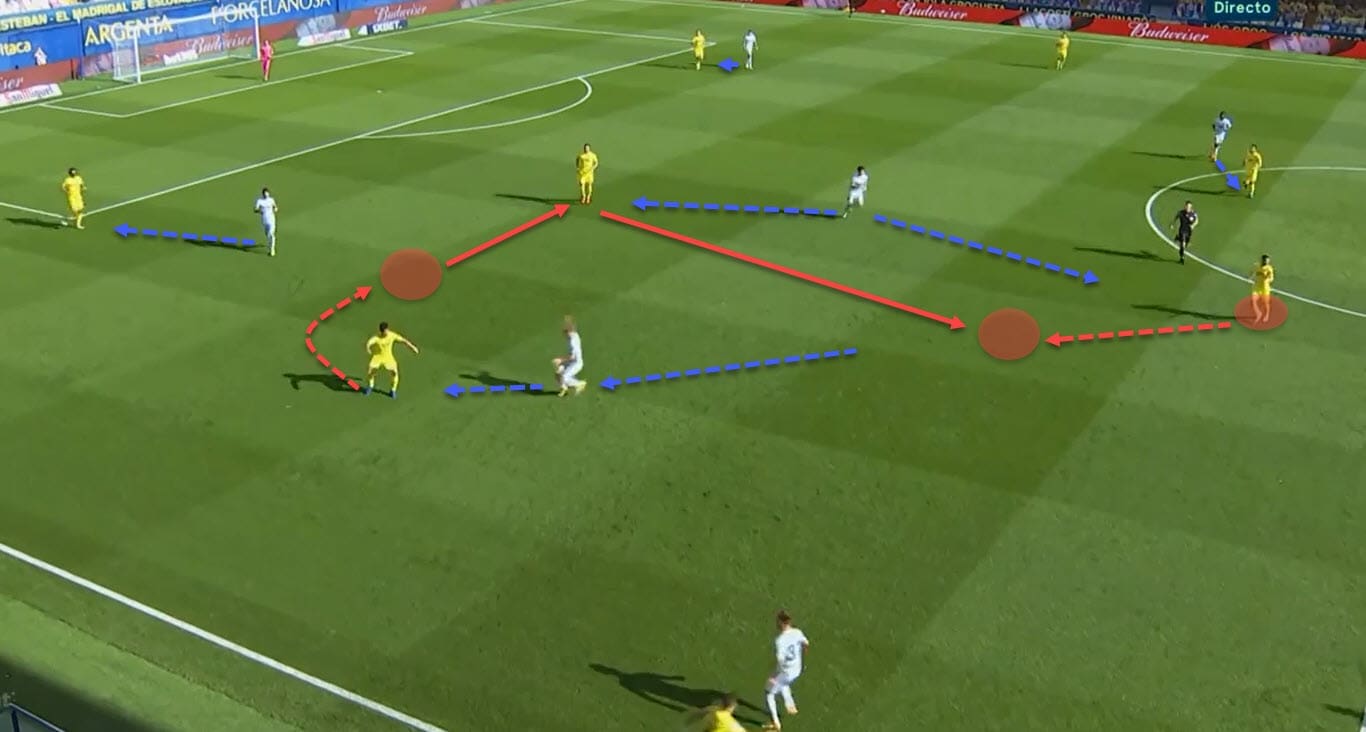
Again, notice the decisional crisis the midfielders are in since there are multiple targets to mark at the same time.
Villarreal’s half-space dominance
It does feel like the tactical battle was mainly won in the half-spaces for Villarreal. This is where their efforts were put in and it’s from that area that the winning goal was scored. But the onus was still on creating overloads as they approached the final third.
Of course, Villarreal have big threats on the wings as well and getting the ball wide and then either cutting inside or crossing was always a good option for them. Below, we can one example of their tactics of getting the ball in their preferred area.
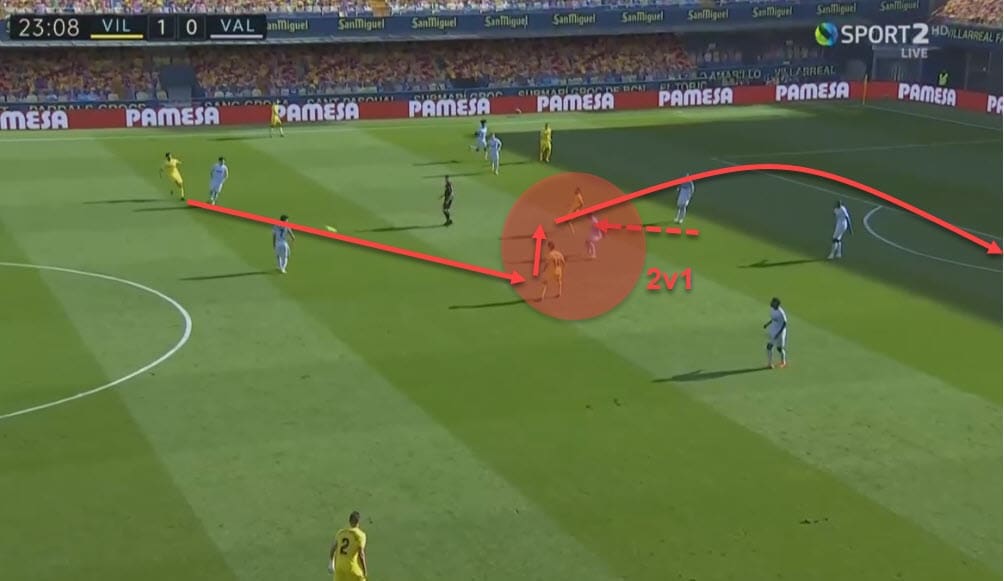
Alcácer drops deeper to create an overload with Iborra and once again, the defender doesn’t know who to mark. A quick one-two between the midfielder and the forward sees the wide player ejected forward within a couple of seconds and Villarreal can attack with intent.
But it’s the tactics once the ball was on the flanks that were particularly interesting. Emery loves inverted wingers but both Chukwueze and Gómez coordinated with their respective full-backs well, knowing when to let them overlap and when to keep the width themselves.
Below, Chukwueze drifts out wide, stretching the Valencia backline and attracting two defenders at the same time. Gaspar recognises this and inverts centrally, occupying that half-space, which we mentioned as crucial at the beginning of this section of the analysis.
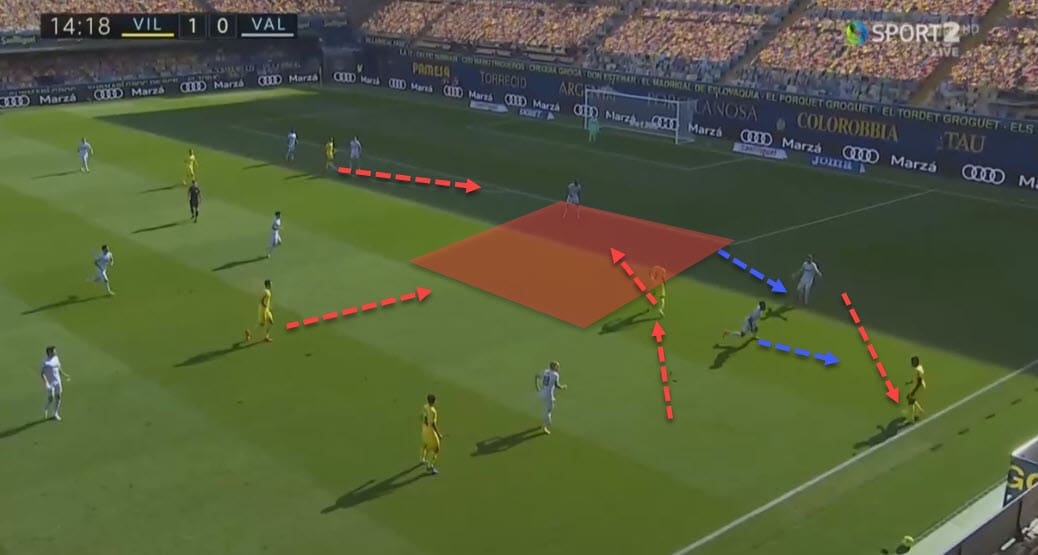
Notice how Villarreal’s players are all drawn towards that area of the pitch because it’s from there that they can cause havoc to the opposition. Let’s explore one more example before we dissect the game-winning action.
Once again the connection between the wide players makes quick work of the defence. One player underlaps while the other stays wide. The former’s movement drags the defenders, leaving the half-spaces free, as highlighted in the following example.
This leaves enough room for a good shot to be deployed from outside the box.
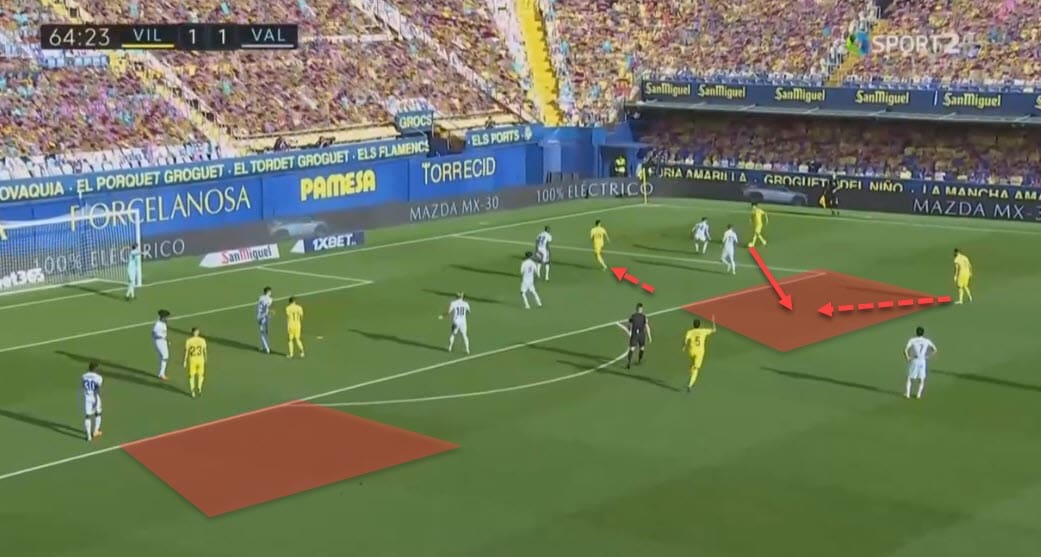
You can already guess where the golden shot from none other than ex-Valencia icon Parejo came from – the half-space. And yes, Parejo did move into the zone 14 while adjusting for his shot but the key pass did come from the left half-space.
Notice the similar patterns once again, as can be seen down below. One player drags the defenders deeper with him into the box, which leaves the higher areas open. And that’s where the oncoming midfielders will usually position themselves when joining the attack.
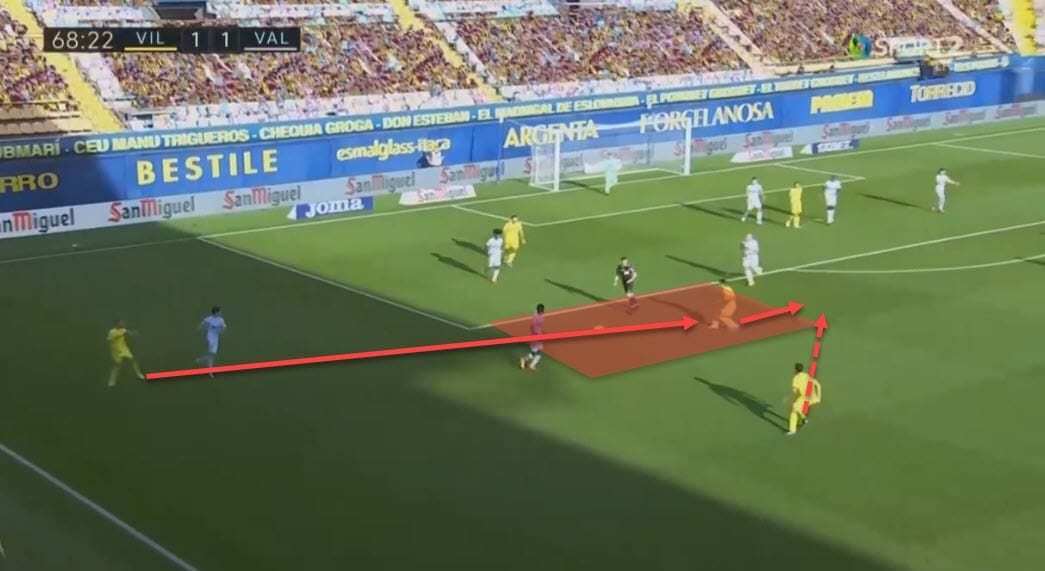
One final look at Villarreal’s passing map from the clash will reveal another crucial aspect of their attacking force. Notice the triangle that formed on both sides of the pitch, involving the winger, the full-back and the midfielder.
This is the main connection in the final third that orchestrates the attacks and moves the opposition. Their interplay and flexibility is something that brilliantly describes Emery’s tactics in a nutshell.
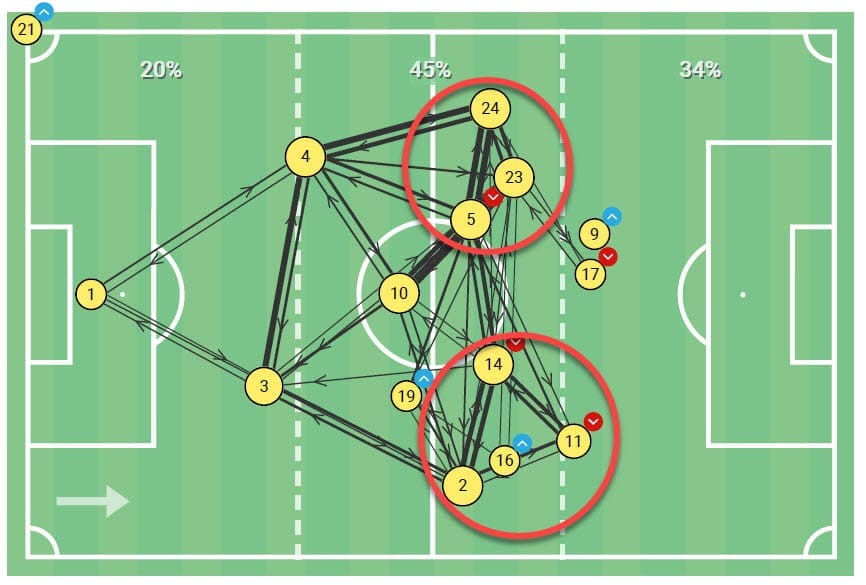
Valencia’s attack and adaptation
With the club being in shambles and the horrible transfer window they’ve had this summer, it’s not that surprising to see Valencia struggle game after game. Gracia has a lot of work to do with this squad but it has to start with proper tactics and execution.
The final part of this tactical analysis will take a brief look at some of their issues and attacking play throughout the game. Initially, Valencia were set up in a 4-4-2 system both in attack and defence but in possession, it would often shift to a 2-4-4.
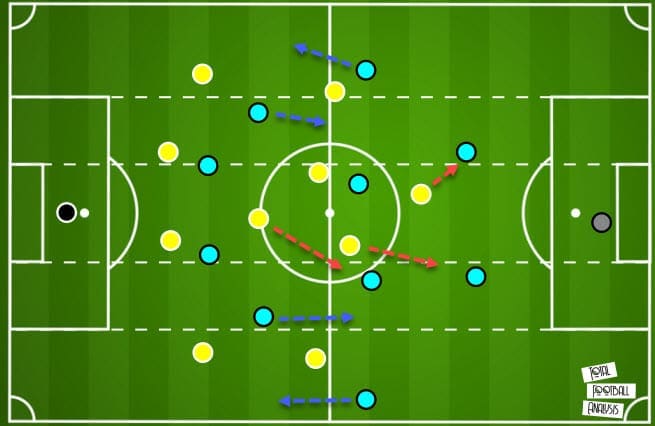
For the majority of the first half, they struggled immensely with Villarreal’s 4-1-4-1 defensive structure, which can also be seen in the graphic above. And while at first, they would have the 2v1 advantage over the opposition’s pressing squad, the hosts would shift to a 4-4-2 or, more commonly, a 4-1-3-2 variation.
This posed a huge problem because Valencia could no longer build from the back and since they refused to drop midfielders to the backline, keeping both Soler and Wass higher for most of the first half, they couldn’t achieve numerical superiority. For that reason, they were often forced into long balls.
We can see this by taking a look at their pass map as well, which is down below.
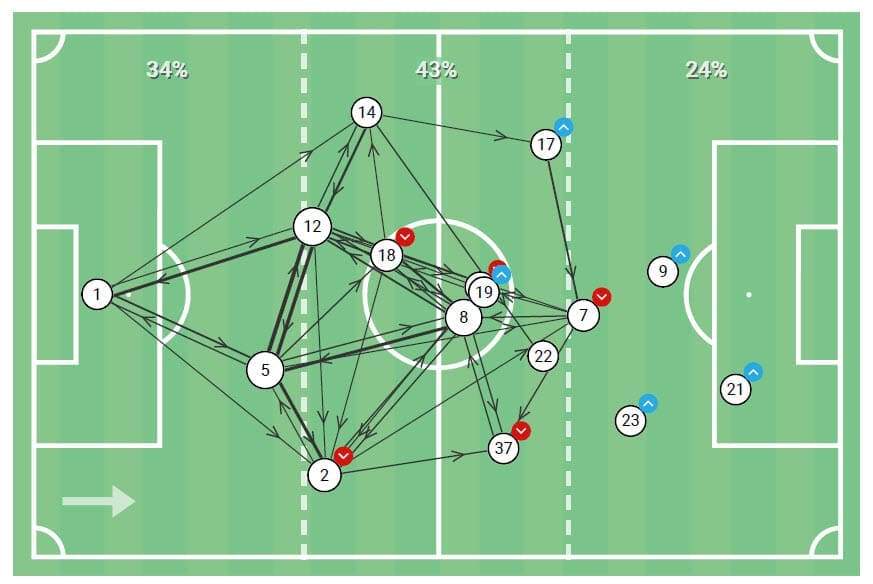
The lack of connections is illustrated by how thin the arrows between most players are. Mostly, the centre-backs combined in an attempt to bypass the Villarreal press but getting the ball up the pitch through positional play was a tall task.
The issues were both in the structure – which, as we’ve mentioned, didn’t lend itself to establishing numerical superiority in the first phase of play – and the movements of the midfielders. Let’s take a look at one in-game example next.
Valencia are trying to advance play but are struggling because there’s a 2v2 duel in the first line. This makes it really difficult to progress the ball.
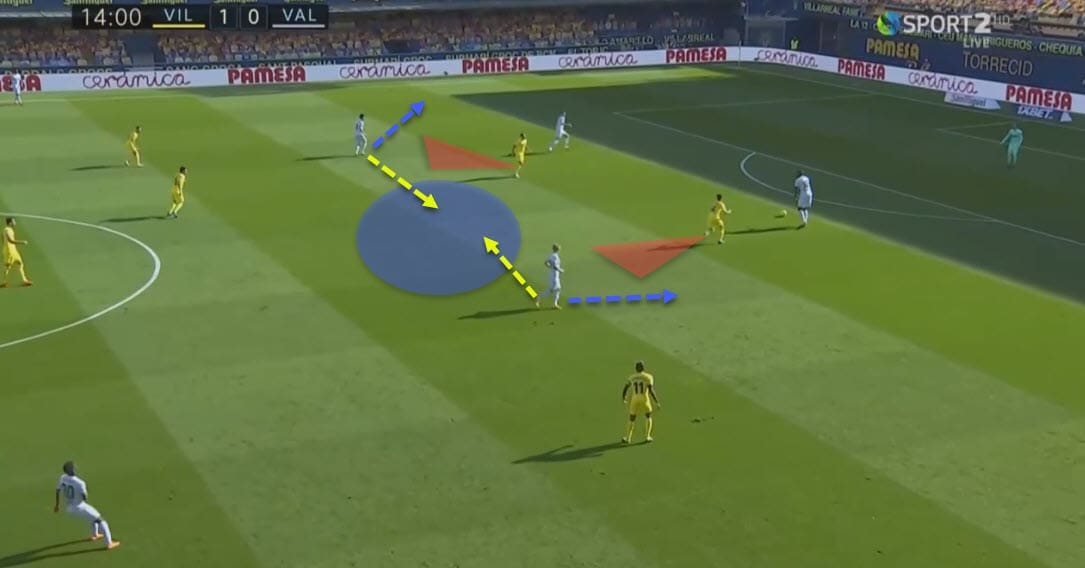
Both Wass and Soler simply have to move into better positions, ideally centrally in this case, to open up a passing channel for Diakhaby to exploit. Soler was on his way to drop into the backline but was kept in Alcácer’s cover shadow so the ball-carrier – who was under pressure as well – had to go long, eventually losing the ball.
It wasn’t all bad, however. As the game progressed, Valencia did find mechanisms to advance the play. The initial plan, which can also be seen in the graphic at the beginning of this section, was to drop players from advanced areas to help the build-up.
Notice in the following example how that usually worked. Here, Wass moved in the right way, dragging his marker with him to open up a new passing channel through the half-space.
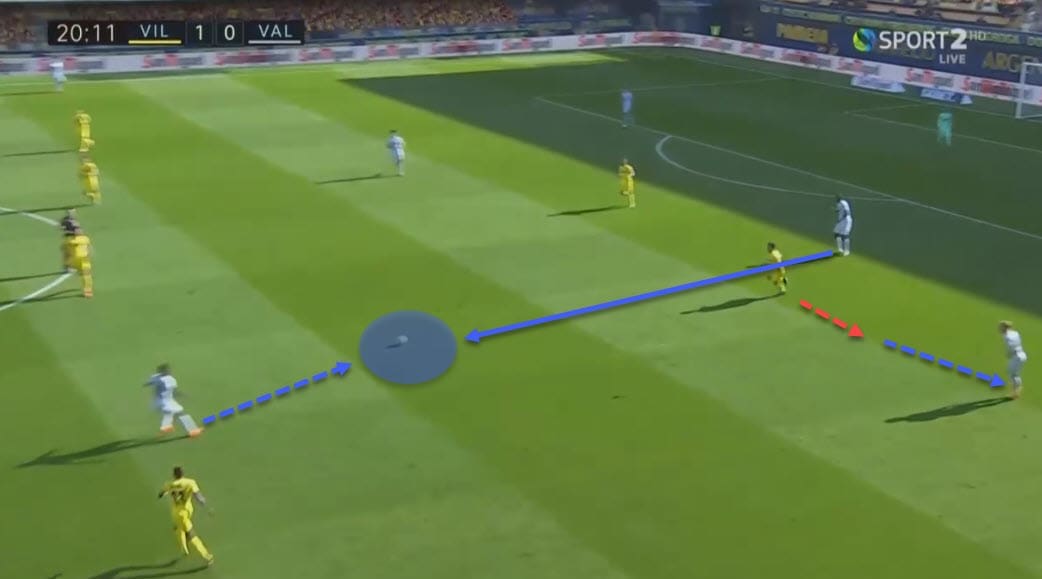
That way, a quick lay-off after receiving the ball can keep the tempo high and also ensure progression. A similar thing was used on the other side where even Guedes would drop to do the same thing.
The wide midfielder can then stay higher to give the dropping attacker a forward channel to exploit. Once again, Valencia succeed to get out of Villarreal’s pressing tactics by creating overloads themselves.
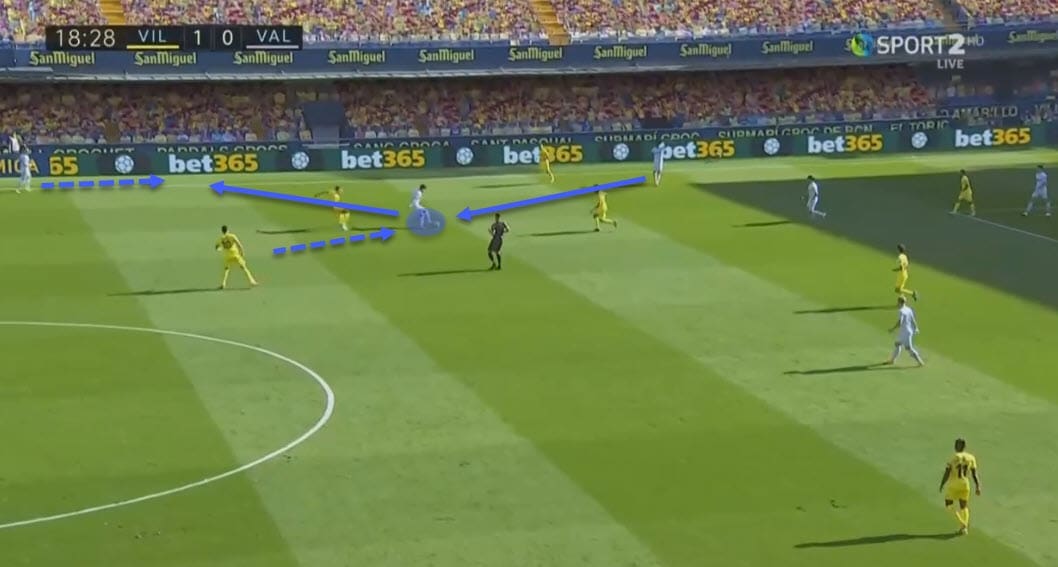
Interestingly, this is very similar to what they tried to do once they reached the final third. Usually, one of the wingers/ wide midfielders would drop deeper to drag their markers away, leaving the full-backs isolated in a 1v1 duel in the backline.
It was either that or the winger himself changing direction quickly to lose his marker and run into space behind the defensive line. In that instance, Valencia could use the long balls and direct routes we talked about earlier in this tactical analysis.
But despite their shaky start and faulty tactics, both in attack and defence, they did adapt throughout the game. Towards the end, we even saw them creating overloads in the first phase of build-up, utilising both the goalkeeper and a dropping midfielder as a mechanism to bypass the press.
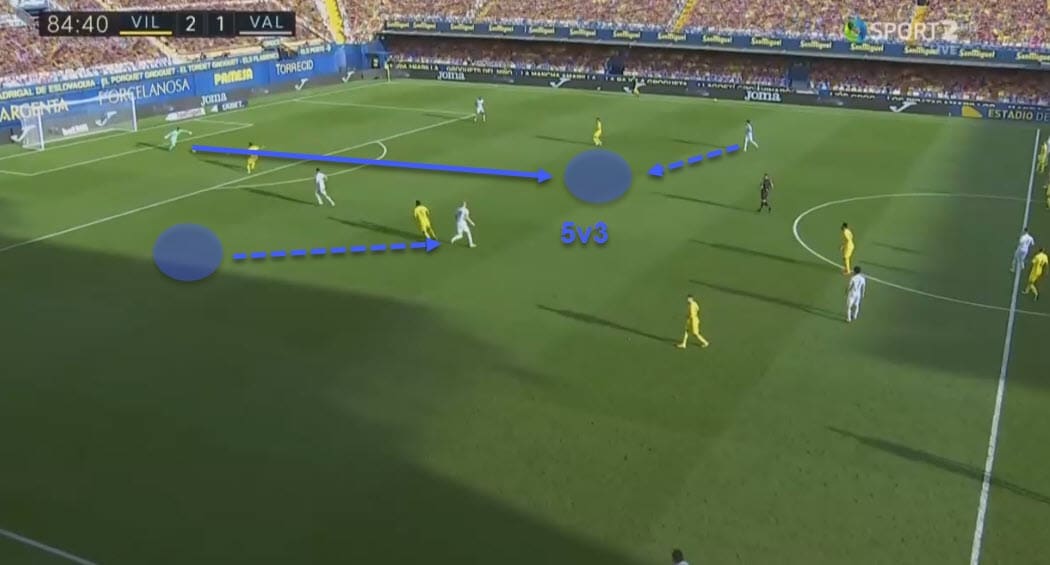
You can see a nice 5v3 overload in the example above as Wass acts as the left centre-back and even Doménech is used as an extra outfield player. If only there was more of that throughout the game and across the pitch.
Conclusion
A 2-1 victory over a shaky Valencia doesn’t look overly impressive for Villarreal. However, Emery’s tactics are starting to show and the Yellow Submarine seems much sharper than at the start of the season.
It is still early days though so we can’t make any strong conclusions as of yet. For Valencia, there’s nowhere to go but up and despite losing again, there were some signs of life, however small they were. And that’s a modest win for them as well.






Comments